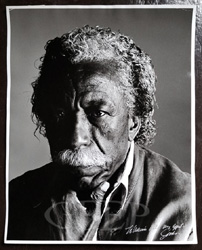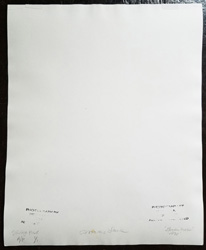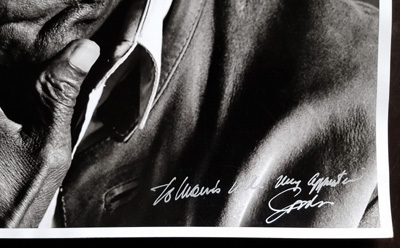GORDON PARKS, BY AFRICAN AMERICAN PHOTOGRAPHER MORRIS LANE
LARGE PORTRAIT WITH INSCRIPTION FROM PARKS TO LANE $2400. USD
PLEASE NOTE. The price, as is the case with all offerings on this website, includes shipping.
We acquired this from Morris Lane, the noted African American photographer. It is the only copy he retained and the only one with an inscription: "To Morris with My Affection Gordon."
Stamped, twice, on the back: "PHOTOGRAPH BY MORRIS LANE COPYRIGHT ALL RIGHTS RESERVED." Handwritten in pencil, on the back: "Vintage Print A/P 1/1," "Morris Lane," and "'Gordon Parks' '1990.'"
UNMOUNTED.
SIZE. Approximately 20 x 16 inches.
CONDITION. Scratch below his eye, left side. A crease to the left of that same eye. A crease at upper left corner, on both photo and border. A crease at upper right corner, on both photo and border. A crease at each of the bottom corners, but only on the border. A few tiny spots. When tilted, some scuffing is apparent at the left edge. On the back, portions of the stamped text are either faded or enough ink wasn't used. Also on the back, 2 pieces of old tape are affixed to the top edge.
APPEARANCE. Masterful lighting. Excellent tones. Sharp details. Fantastic size.
GORDON PARKS. "Gordon Parks, one of the greatest photographers of the twentieth century, was a humanitarian with a deep commitment to social justice. He left behind an exceptional body of work that documents American life and culture from the early 1940s into the 2000s, with a focus on race relations, poverty, civil rights, and urban life. Parks was also a distinguished composer, author, and filmmaker... he won the Julius Rosenwald Fellowship in 1942; this led to a position with the photography section of the FSA in Washington, D.C., and, later, the Office of War Information (OWI). Working for these agencies, which were then chronicling the nation's social conditions, Parks quickly developed a personal style that would make him among the most celebrated photographers of his era... In 1944, Parks left the OWI to work for the Standard Oil Company's photo documentary project. Around this time, he was also a freelance photographer for Glamour and Ebony, which expanded his photographic practice and further developed his distinct style. His 1948 photo essay on the life of a Harlem gang leader won him widespread acclaim and a position as the first African American staff photographer for Life. Parks would remain at the magazine for two decades, covering subjects ranging from racism and poverty to fashion and entertainment, and taking memorable pictures of such figures as Muhammad Ali, Malcolm X, Adam Clayton Powell, Jr., and Stokely Carmichael... Parks was a modern-day Renaissance man, whose creative practice extended beyond photography to encompass fiction and nonfiction writing, musical composition, filmmaking, and painting. In 1969 he became the first African American to write and direct a major Hollywood studio feature film, The Learning Tree, based on his bestselling semiautobiographical novel. His next film, Shaft (1971), was a critical and box-office success, inspiring a number of sequels. Parks published many books, including memoirs, novels, poetry, and volumes on photographic technique. In 1989 he produced, directed, and composed the music for a ballet, Martin, dedicated to the late civil rights leader Martin Luther King, Jr. Parks spent much of the last three decades of his life evolving his style, and he continued working until his death in 2006. He was recognized with more than fifty honorary doctorates, and among his numerous awards was the National Medal of Arts, which he received in 1988. Today, archives of his work reside at a number of institutions, including the Gordon Parks Foundation, Pleasantville, New York; the Gordon Parks Museum in Fort Scott, Kansas, and Wichita State University in Wichita; and the Library of Congress, the National Archives, and the Smithsonian Institution, all in Washington, D.C. Parks's work is in the permanent collections of major museums, among them the Art Institute of Chicago; the Baltimore Museum of Art; the Cincinnati Art Museum; the Detroit Institute of Arts; the International Center of Photography, the Metropolitan Museum of Art, and the Museum of Modern Art, all in New York; the Minneapolis Institute of Art; the Museum of Fine Arts, Houston; the Saint Louis Art Museum; the Smithsonian National Museum of American History, Washington, D.C.; and the Virginia Museum of Fine Arts, Richmond. (Recent exhibitions) include: Gordon Parks: The Atmosphere of Crime, Museum of Modern Art (2020); Gordon Parks X Muhammad Ali, Nelson Atkins Museum of Art (2020); Gordon Parks: The Flávio Story, Instituto Moreira Salles, São Paulo (traveled; 2017–2019); Gordon Parks: The New Tide, Early Work 1940–1950, National Gallery of Art, Washington, D.C. (traveled; 2018–2019); I Am You: Selected Works 1942–1978, C/O Berlin (traveled; 2017–2018); Invisible Man: Gordon Parks and Ralph Ellison in Harlem, Art Institute of Chicago (2016); Gordon Parks: Back to Fort Scott, Museum of Fine Arts, Boston (2015); Gordon Parks: Segregation Story, High Museum of Art, Atlanta (2014–2015); Gordon Parks: The Making of an Argument, New Orleans Museum of Art (2013–2014); and Gordon Parks: A Harlem Family 1967, The Studio Museum in Harlem (2012–2013)." (source: The Gordon Parks Foundation website)


